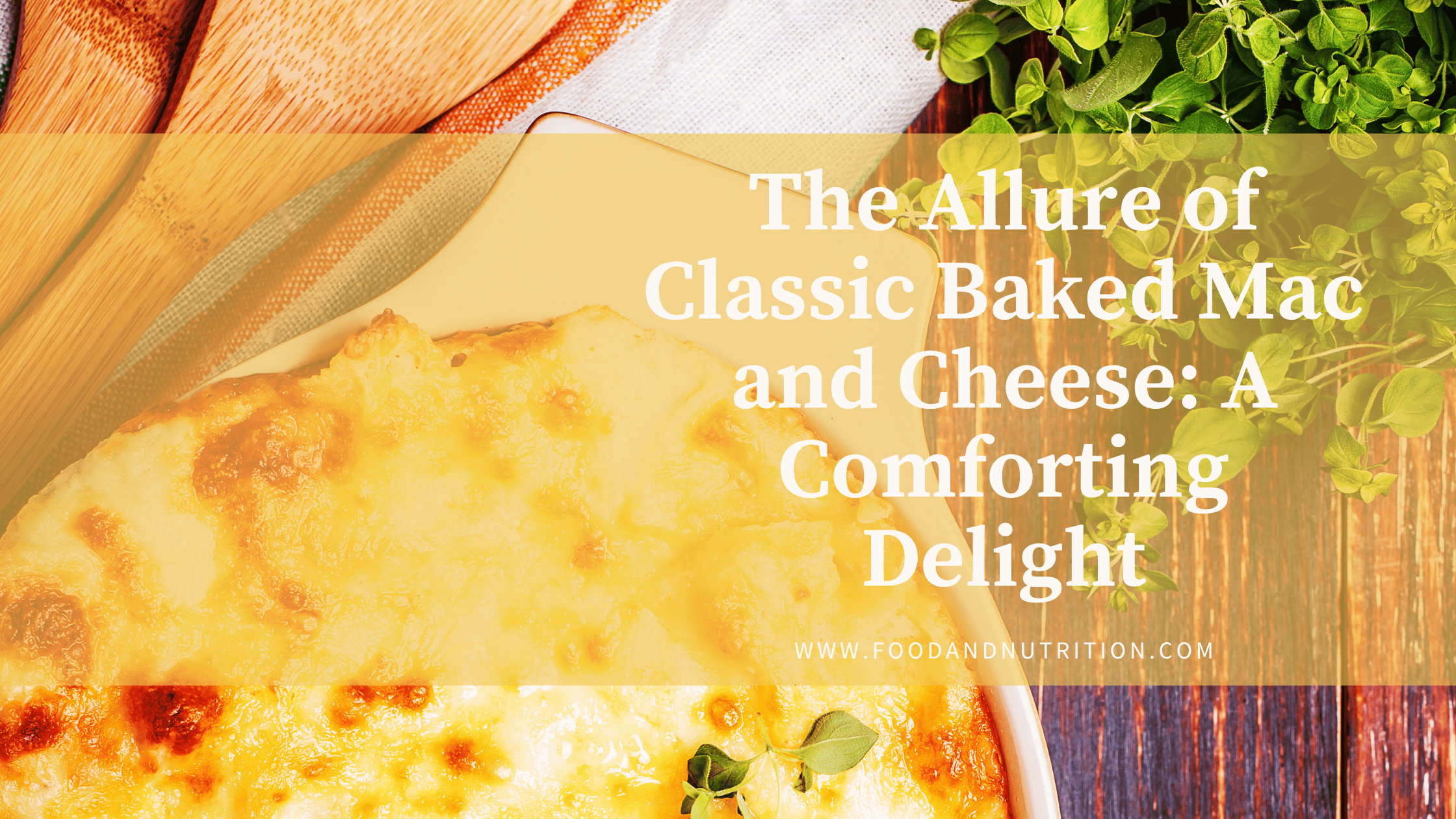The Allure of Classic Baked Mac and Cheese: A Comforting Delight

Mac and cheese, the quintessential comfort food, holds a special place in the hearts and palates of many. Whether we recall childhood memories or simply crave a warm, cheesy indulgence, mac and cheese has earned its spot as a beloved classic. In this blog post, we delve into the history, popularity, key ingredients, nutrition, serving ideas, and chef tips surrounding the timeless favorite: the classic baked mac and cheese recipe.
The History
Mac and cheese traces its origins back to the ancient Romans, who combined pasta with melted cheese. However, it wasn’t until the 18th century that the dish gained popularity in modern form. Thomas Jefferson, a food enthusiast, tasted mac and cheese during his travels to Italy and brought back a pasta machine to replicate the dish in the United States. By incorporating macaroni, cheese, and a simple white sauce, mac and cheese became a beloved American comfort food.
The Popularity
What makes classic baked mac and cheese such a crowd-pleaser? The answer lies in its rich, creamy, and satisfying flavors. The combination of tender elbow macaroni enveloped in a velvety cheese sauce, topped with a golden baked crust, creates an irresistible blend of textures and tastes. It’s a dish that appeals to people of all ages and backgrounds, evoking a sense of nostalgia and offering a comforting respite from the hustle and bustle of everyday life.
Key Ingredients
The key ingredients of a classic baked mac and cheese recipe include elbow macaroni, butter, flour, milk, shredded sharp cheddar cheese, shredded mozzarella cheese, salt, black pepper, paprika (optional), and grated Parmesan cheese. These simple ingredients come together to create a harmonious symphony of flavors, with each component playing a crucial role in the overall taste and texture of the dish.
Classic Baked Mac and Cheese Recipe
Ingredients
- 8 ounces 225g elbow macaroni
- 4 tablespoons 57g unsalted butter
- 1/4 cup 32g all-purpose flour
- 2 1/2 cups 590ml milk
- 2 cups 200g shredded sharp cheddar cheese
- 1 cup 100g shredded mozzarella cheese
- 1/2 teaspoon salt
- 1/4 teaspoon black pepper
- 1/4 teaspoon paprika optional
- 1/4 cup 25g grated Parmesan cheese
Instructions
- Preheat the oven to 350°F (175°C) and grease a baking dish with butter or cooking spray.
- Cook the elbow macaroni according to the package instructions. Drain and set aside.
- In a large saucepan, melt the butter over medium heat. Add the flour and whisk continuously for about 1-2 minutes until it turns slightly golden.
- Slowly pour in the milk while whisking constantly to avoid lumps. Continue whisking until the mixture thickens and comes to a gentle simmer.
- Remove the saucepan from the heat and add the shredded cheddar cheese, mozzarella cheese, salt, black pepper, and paprika. Stir until the cheeses are melted and the sauce is smooth.
- Add the cooked macaroni to the sauce and stir until the pasta is evenly coated.
- Transfer the mac and cheese mixture to the greased baking dish and spread it out evenly. Sprinkle the grated Parmesan cheese on top.
- Bake in the preheated oven for about 20-25 minutes or until the top is golden and the cheese is bubbly.
- Remove from the oven and let it cool for a few minutes before serving.
Notes
Nutrition
While mac and cheese may not be considered a health food, it can still be enjoyed as part of a balanced diet. It provides a good source of carbohydrates from the pasta, protein and calcium from the cheese, and essential nutrients from the milk and butter. To make it slightly healthier, you can opt for whole wheat or gluten-free macaroni and use reduced-fat cheese and milk. Adding vegetables like steamed broccoli or roasted butternut squash can also boost the nutritional value of the dish.
Serving Ideas
Classic baked mac and cheese can stand on its own as a delightful main dish, but it also pairs well with various accompaniments. Serve it alongside a crisp green salad with a tangy vinaigrette or roasted vegetables for a well-rounded meal. For a heartier option, top it with crumbled bacon or diced ham. Get creative by adding flavorsome ingredients like caramelized onions, sun-dried tomatoes, or sautéed mushrooms to elevate the dish further.
Chef Tips
To achieve the perfect mac and cheese, here are a few chef tips to keep in mind:
- Cook the pasta al dente: Ensure the macaroni is cooked until it is still slightly firm, as it will continue to cook during the baking process.
- Use a combination of cheeses: Blend different types of cheeses for a more complex flavor profile. Sharp cheddar provides a robust taste, while mozzarella adds gooeyness and stretchiness.
- Let it rest before serving: Allowing the baked mac and cheese to rest for a few minutes before serving helps the flavors meld together and makes it easier to portion.
Conclusion
Classic baked mac and cheese holds a special place in our culinary repertoire for its comforting flavors and ability to evoke fond memories. With its rich history, widespread popularity, and a myriad of serving possibilities, this dish continues to captivate taste buds around the world. Whether enjoyed as a simple family dinner or a centerpiece at gatherings, the allure of classic baked mac and cheese is timeless. Indulge in this beloved classic and savor the warm, cheesy goodness that never fails to bring joy to the table.
- Discover the Nordic Diet: A Path to Health and Sustainability
- Ultimate Guide to Nutrition & Wellness Tips for Healthy Travel Adventures
- Personalized Menu Planning: Tailoring Nutrition to Individual Needs
- Discover the Best Healthy Cooking Oils: Benefits, Uses, and Expert Tips
- Savor the Sunshine Flavors: Lemon Chicken Skewers for Grilling Bliss
- Ultimate Guide to Adaptogens: Benefits, Uses, and How to Incorporate Them
